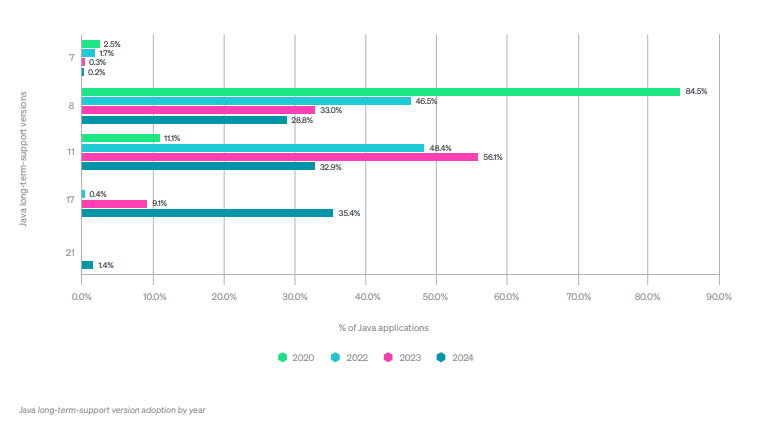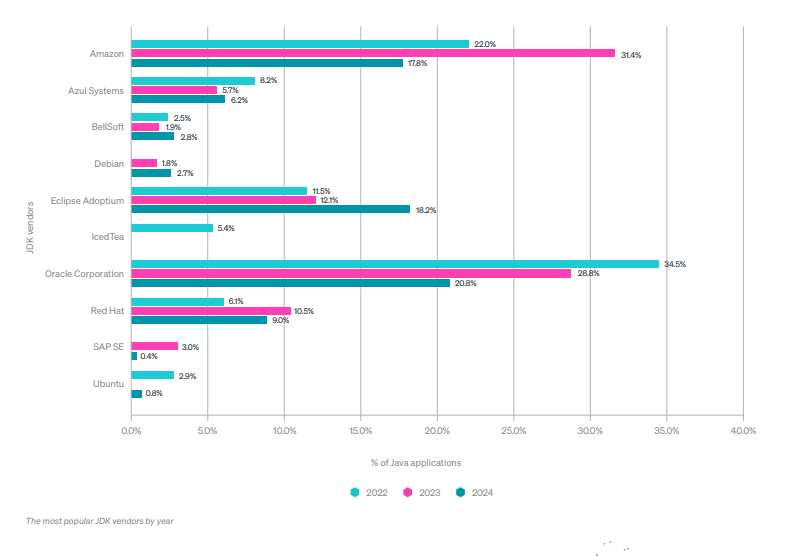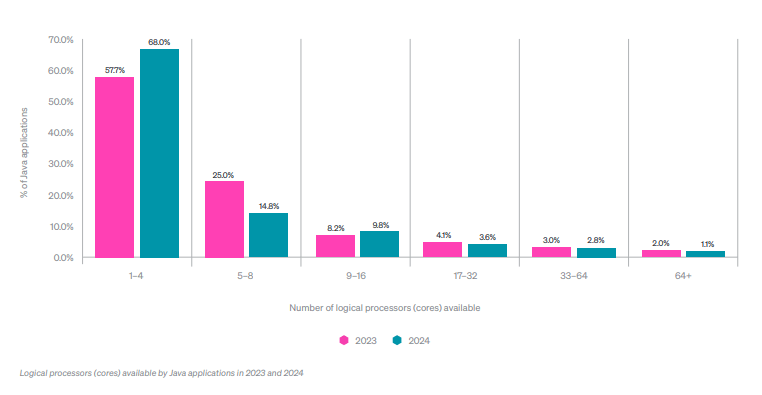Key Findings from the Report
The “2024 State of the Java Ecosystem” report provides a comprehensive overview of current trends and statistics in Java usage, focusing on aspects such as version adoption, JDK vendors, and application configurations. Below are the key findings from the report in detail:
1. Java Version Adoption:
-
- Java 21, released in September 2023, saw a rapid adoption compared to previous versions. Within six months of its release, 1.4% of applications monitored were using it, a significant increase from the 0.37% adoption rate of Java 17 in the same timeframe post-release.

-
- The report notes a growing trend in faster adoption of new Java versions, particularly the long-term support (LTS) versions. Java 17’s adoption surged to 35% of applications by 2023, indicating a nearly 300% growth rate within a year.
2. JDK Vendor Trends:

-
- Oracle, once the dominant JDK vendor with a 75% market share in 2020, has seen a gradual decline to 21% by 2024. This shift is attributed to restrictive licensing and the rise of community-supported JDKs.
- Eclipse Adoptium has emerged as a significant player, with its adoption increasing by 50% year-over-year, reaching an 18% market share in 2024. This rise reflects the community’s preference for more frequently updated and openly managed JDKs.
3. Java Application Configurations:
-
- Garbage collectors: The Garbage-First (G1) collector is the most used, being the default choice in newer Java versions and used by 43% of the applications. It is favored for its efficiency in managing both young and old generations of garbage collection.
- Compute and memory usage: There has been a noticeable trend towards running applications with fewer cores, especially in cloud environments, with 68% of Java applications using between one to four cores as of 2024.
 4. Popular Frameworks and Libraries:
4. Popular Frameworks and Libraries:
-
- Logging: Log4j remains the most popular framework, used by 76% of Java applications, followed by JBoss Logging and Logback.
- Encryption: Bouncy Castle leads in encryption libraries, used by 17% of applications, reflecting its comprehensive suite of cipher functionalities.
- Databases: Oracle Database is the top choice for Java applications requiring robust data management capabilities, followed by PostgreSQL and MySQL, highlighting a diverse preference for database systems based on application needs.
5. Developer Queries and Assistance:
Developers predominantly seek assistance for how-to questions (34%), configuration issues (14%), and performance troubleshooting (6%). These inquiries often revolve around logging practices, application monitoring, and efficient use of frameworks.
Finally
In conclusion, the report highlights the predominant Java application configurations and the popular frameworks and libraries that are shaping Java development practices. These trends not only inform developers but also guide enterprise decisions regarding technology strategies and investments.
As Java continues to be a cornerstone in the development of robust, scalable applications, understanding these trends is crucial for anyone involved in the Java ecosystem. Stakeholders are encouraged to consider these insights to optimize their development practices, improve application performance, and enhance the overall efficiency of their Java-based systems. The ongoing evolution of Java is a testament to its resilience and enduring relevance in the face of emerging technologies and programming paradigms.
Also Read: Unlocking Day 2 at Qualtrics X4 Summit 2024: Insights and Highlights
FAQs
1. What are the key features of Java 21?
Java 21 introduces several enhancements including improvements to virtual threads, upgraded libraries, and syntax advancements that align Java with more modern programming languages. These features aim to improve the overall performance and developer experience.
2. Why is Eclipse Adoptium becoming more popular among JDK vendors?
Eclipse Adoptium is gaining popularity due to its community-driven approach, which ensures frequent updates and improvements. This JDK is openly managed, making it an attractive option for developers seeking flexibility and the latest Java features without the constraints of more traditional, commercial JDKs.
3. What is the significance of the Garbage-First (G1) collector in Java applications?
The Garbage-First (G1) collector is significant because it optimizes garbage collection by managing memory allocation in smaller, more manageable regions, thus enhancing performance. It has become the default garbage collector in newer Java versions due to its efficiency and ability to handle large memory spaces.
4. Which Java frameworks and libraries are most popular for logging and encryption?
For logging, Log4j is the most popular due to its robust features and ease of integration. For encryption, Bouncy Castle is widely used because of its extensive collection of cipher suites and cryptographic algorithms.
5. How are Java versions being adopted in the industry?
The adoption rates of Java versions are increasing, with newer versions such as Java 21 seeing quicker uptake compared to older versions. This trend is driven by the significant improvements and features introduced in these newer releases that address developer needs and application requirements.
6. How does the report gather its data on Java usage?
The data in the report is gathered from hundreds of thousands of applications that report to New Relic, providing a comprehensive view of real-world Java usage across different industries and application types.
7. What implications do these findings have for Java developers and enterprises?
The findings suggest that staying updated with the latest Java versions and adopting flexible, community-supported JDKs like Eclipse Adoption can lead to better application performance and developer productivity. Enterprises should consider these trends when planning their technology strategies to leverage the strengths of Java effectively.
[To share your insights with us as part of editorial or sponsored content, please write to sghosh@martechseries.com]



 4. Popular Frameworks and Libraries:
4. Popular Frameworks and Libraries: